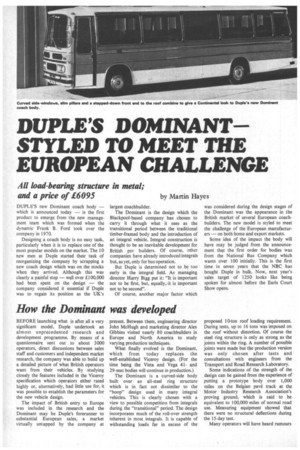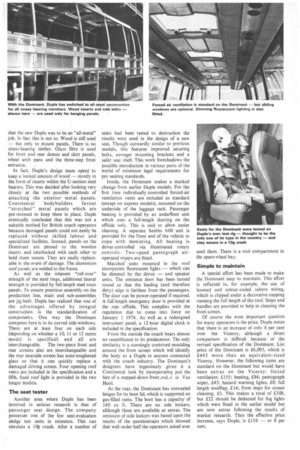How the Dominant was developed
Page 42

Page 43

If you've noticed an error in this article please click here to report it so we can fix it.
BEFORE launching what is after all a very significant model, Duple undertook an almost unprecedented research and development programme. By means of a questionnaire sent out to about 3000 operators, direct discussions between sales staff and customers and independent market research,, the company was able to build up a detailed picture of what British operators want from their vehicles. By studying closely the features included in the Viceroy specification which operators either rated highly or, alternatively, had little use for, it was possible to establish the parameters for the new vehicle design.
The impact of British entry to Europe was included in the research and the Dominant may be Duple's forerunner to substantial European sales, a market virtually untapped by the company at present. Between them, engineering director John McHugh and marketing director Alex Gibbins visited nearly 80 coachbuilders in Europe and North America to study varying production techniques.
What finally evolved is the Dominant, which from today replaces the well-established Viceroy design. (For the time being the Vista and Vega 41and 29-seat bodies will continue in production.) The Dominant is a curved-side body built over an all-steel ring structure which is in fact not dissimilar to the "hoop" design used in many integral vehicles. This is clearly chosen with a view to possible competition from integrals during the "transitional" period. The design incorporates much of the roll-over strength inherent in most integrals. It is capable of withstanding loads far in excess of the proposed 0-ton roof loading requirement. During tests, up to 16 tons was imposed on the roof without distortion. Of course the steel ring structure is only as strong as the joints within the ring. A number of possible joints were made but the production version was only chosen after tests and consultations with engineers from the Transport and Road Research Laboratory.
Some indications of the strength of the design can be gained from the experience of putting a prototype body over 1,000 miles on the Belgian pave track at the Motor Industry Research Association's proving ground, which is said to be equivalent to 100,000 miles of normal road use. Measuring equipment showed that there were no structural deflections during the 15-day test.
Many operators will have heard rumours that the new Duple was to be an "all-metal" job. In fact this is not so. Wood is still used — but only to mount panels. There is no stress-bearing timber. Glass fibre is used for front and rear domes and skirt panels, wheel arch pans and the three-step front entrance. , In fact, Duple's design team opted to keep a limited amount of wood — mostly in the form of inserts within the U-section steel bearers. This was decided after looking very closely at the two possible methods of attaching the exterior metal panels. Continental bodybuilders favour "stretched" Metal panels which are pre-stressed to keep them in place. Duple eventually concluded that this was not a suitable method for British coach operators because damaged panels could not easily be replaced without skilled labour and specialized facilities. Instead, panels on the Dominant are pinned to the wooden inserts and interlocked with each other to hold them secure. They are easily replaceable in the event of damage. The aluminium roof panels are welded to the frame.
As well as the inherent "roll-over" strength of the steel rings, additional lateral strength is provided by full-length steel truss panels. To ensure precision assembly on the production line, main and sub-assemblies are jig-built. Duple has realized that one of the advantages offered by integral construction is the• standardization of components. One way the Dominant competes here is in its curved side-windows. There are at least four on each side (depending on whether a 10, 11 or 12 metre model is specified) and all are interchangeable. The two-piece front and rear screens also are interchangeable and the rear nearside screen has zone-toughened glass so that it can quickly replace a damaged driving screen. Four opening roof vents are included in the specification and a fifth, fixed roof light is provided in the two longer models.
The seat tester Another area where Duple has been involved in serious research is that of passenger seat design. The company possesses one of the few seat-evaluation sledge test units in existence. This can simulate a 1Og crash. After a number of seats had been tested to destruction the results were used in the design of a-new seat. Though outwardly similar to previous models, this features improved securing bolts, stronger mounting brackets and a safer seat shell. This work foreshadows the possible introduction in various parts of the world of minimum legal requirements for psv seating standards.
Inside, the Dominant makes a marked change from earlier Duple models. For the first time individually controlled forced-air ventilation vents are included as standard v(except on express models), mounted on the underside of the luggage rack. Passenger heating is provided by an underfloor unit which uses a full-length ducting on the offside only. This is said to allow easier cleaning. A separate Smiths 600 unit is provided for the front end of the vehicle to cope with demisting. All heating is driver-controlled via illuminated rotary controls. Two-speed pantograph air operated wipers are fitted.
Matched units mounted in the roof incorporate fluorescent lights — which can be dimmed by the driver — and speaker units. The entrance door has been turned round so that the leading (and therefore dirty) edge is farthest from the passengers. The door can be power-operated if required. A full-length emergency door is provided at the rear offside. This complies with the regulation due to come into force on January 1 1974. As well as a redesigned instrument panel, a 12-hour digital clock is included in the specification.
From the outside the coach bears almost no resemblance to its predecessor. The only similarity is a cunningly contrived moulding around the front screen which will identify the body as a Duple to anyone connected with the coach industry. The Dominant's designers have ingeniously given it a Continental look by incorporating just the hint of a stepped-down front end, c In Van Hool.
At the rear, the Dominant has concealed hinges for its boot lid, which is supported on gas-filled rams. The boot has a capacity of 140 cu ft. There are no side lockers, although these are available as extras. The omission of side lockers was based upon the results of the questionnaire which showed that well under half the operators asked ever used them. There is a tool compartment in the spare-wheel bay.
Simple to maintain A special effort has been made to make the Dominant easy to maintain. This effort is reflected in, for example, the use of loomed and colour-coded saloon wiring, which is clipped under a decorative capping running the full length of the roof. Steps and handles are provided to help in cleaning the front screen.
Of course the most important question for many operators is the price. Duple states that there is an increase of only 8 per cent over the Viceroy, although a direct comparison is difficult because of the revised specification of the Dominant. List price of the Dominant is £6,095, which is £445 more than an equivalent-sized Viceroy. However, the following items are standard on the Dominant but would have been extras on the Viceroy: forced ventilation, £155; heating, £84; pantograph wiper, £43; hazard warning lights, £8; full length mudflap, £14; front steps for screen cleaning, £5. This makes a total of £309, but £22 should be deducted for fog lights which were fitted to the earlier model but are now extras following the results of market research. Thus the effective price
increase, says Duple, is £158 or 8 per cent.


































































































